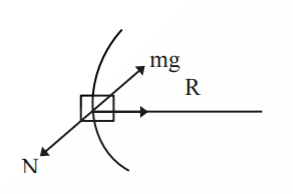A car moves with speed on a horizontal circular track of radius . A head-on view of the car is shown in figure. The height of the car's centre of mass above the ground is , and the separation between its inner and outer wheels is The road is dry, and the car does not skid. The maximum speed the car can have without overturning is :
 .
.
The correct Answer is:A
(a) When the car is on the point of rolling over, the normal force on its inside wheels is zero.
Take torque about the centre of mass :
Then by substitution,
A wider wheelbase (larger ) and a lower centre of mass (smaller ) will reduce the risk of rollover.
 .
.
Topper's Solved these Questions
- ROTATIONAL DYNAMICSBook:A2ZChapter:ROTATIONAL DYNAMICSExercise:Assertion Reasoning
Explore 20 Videos
- ROTATIONAL DYNAMICSBook:A2ZChapter:ROTATIONAL DYNAMICSExercise:NEET Questions
Explore 59 Videos
- ROTATIONAL DYNAMICSBook:A2ZChapter:ROTATIONAL DYNAMICSExercise:Rotation And Translation Combined And Rolling Motion
Explore 18 Videos
- PROPERTIES OF MATTERBook:A2ZChapter:PROPERTIES OF MATTERExercise:Chapter Test
Explore 29 Videos
- THERMAL PROPERTIES OF MATTERBook:A2ZChapter:THERMAL PROPERTIES OF MATTERExercise:Chapter Test
Explore 30 Videos
Similar Questions
A car moves with speed v on a horizontal circular track of radius R. A head-on view of the car is shown in figure. The height of the car's centre of mass above the ground h, and the separation between its inner and outer wheel, is d. The road is dry, and the car does not skid. Show that the maximum speed the car can have without overturning is given by vmax=√gRd2h. To reduce the risk of rollover, should one increase or decrease h? Should one increase or decrease the width d of the wheel base?

View SolutionA car of maas M is moving on a horizontal circular path of radius r. At an instant its speed is v and is increasing at a rate a.
View Solution
Knowledge Check
If a car is to travel with a speed v along the frictionless, banked circular track of radius r, the required angle of banking so that the car does skid is
Aθ=tan−1(v2rg)Bθ=tan−1(vrg)Cθ=tan−1(r2rg)Dθ=tan−1(v22rg)A car is moving with velocity v on circular turn of radius R. Mass of the car is m. Evaluate the negative lift (FL) acting on the car
 Amv2μR−2mgBmv22μR−2mgCmv2μR−mgDmv23μR−mg
Amv2μR−2mgBmv22μR−2mgCmv2μR−mgDmv23μR−mgA car is moving at a speed of 40 m/s on a circular track of radius 400 m. Its speed is increasing at the rate of 3 m/s2. The acceleration of car is
A4 m/s2B7 m/s2C5 m/s2D3 m/s2
A car of maas M is moving on a horizontal circular path of radius r. At an instant its speed is v and is increasing at a rate a.
View SolutionA car goes on a horizontal circular road of radius R. The speed of car is increasing at constant rate a m/s2. If the friction coefficient between the road and the tyre is μ, then the limiting speed of car is
View SolutionA car starts rest, on a horizontal circular road of radius R, the tangential acceleration of the car is a. The friction coefficient between the road and the tyre is μ Find the speed at which car will skid and also find the distance after travelling it skids.
View SolutionA car has to move on a level turn of radius 45 m. If the coefficient of static friction between the tire and the road is μs=2.0, find the maximum speed the car can take without skidding.
View SolutionA car is moving with speed of 10m/s in a concave road of radius 100 m .If the mass of the car is 700 kg, then the reaction on the car tyres when it is at the lowest position will be
View Solution

